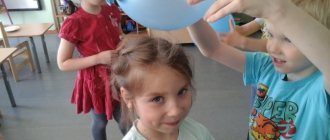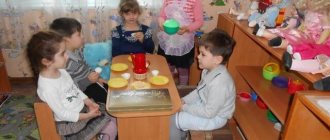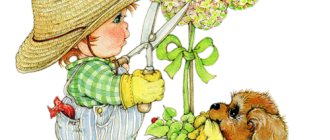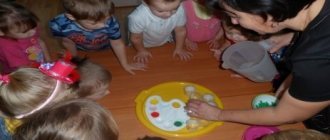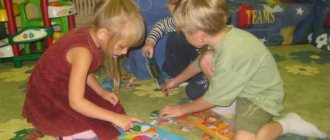Independent play activities of preschool children
Zhiltsova Inna Anatolyevna
Independent play activities of preschool children
In the pedagogical theory of play, special attention is paid to the study of play as a means of education. The fundamental position is that in preschool age play is the type of activity in which the personality is formed and its internal content is enriched. The main meaning of the game associated with the activity of imagination is that the child develops the need to transform the surrounding reality, the ability to create something new.
The educational possibilities of all types of games are extremely great. It is important for adults to implement them in such a way as not to disrupt the natural flow of the game and not to deprive it of its “soul”
a remark, an indication, a notation, just a careless word.
The relevance of this topic is due to the introduction into practice of the Federal State Standard of Preschool Education (hereinafter referred to as the Federal State Educational Standard for Preschool Education), the Federal Law “On Education in the Russian Federation”
and the need to reconsider the organization
of play activities in preschool educational institutions in accordance with the requirements for preserving the uniqueness and intrinsic value of preschool childhood as an important stage in the overall development of a person.
The novelty lies in the formation in teachers of the ability to organize play activities a way that will ensure “diversity of childhood, full-fledged living by the child at all stages of preschool childhood , amplification (enrichment)
child development, creating a favorable social situation for the development of each child in accordance with his
age and individual characteristics and inclinations.”
of a preschool child are expressed in play . First of all, a child is characterized by a desire for independence and active participation in the lives of adults. As the child develops, the world he is aware of expands, and an internal need arises to participate in adult activities that are inaccessible to him in real life. In play, the child takes on a role, trying to imitate those adults whose images have been preserved in his experience. While playing, the child acts independently , freely expressing his desires, ideas, and feelings.
As a leading activity , play most contributes to the formation of a child’s new formations, his mental processes, including imagination. One of the first to connect the development of play with the characteristics of children's imagination was K. D. Ushinsky. He drew attention to the educational value of images of imagination: the child sincerely believes in them, therefore, while playing, he experiences strong, genuine feelings.
The basis of the new classification of children's games, developed by S. L. Novoselova, is the idea of on whose initiative games arise (child or adult)
.
There are three classes of games:
1. games that arise on the initiative of the child ( children , - independent games :
1.1. game-experimentation;
1.2. independent plot games : plot-display, plot-role-playing, director's, theatrical;
2. games that arise on the initiative of an adult who introduces them for educational and educational purposes:
2.1. educational games: didactic, plot-didactic, active;
2.2.leisure games: fun games, entertainment games, intellectual games, festive carnival games, theatrical performance games;
3. games that come from the historically established traditions of the ethnic group (folk, which can arise on the initiative of both an adult and older children : traditional or folk (historically they form the basis of many educational and leisure games).
Directing games are a type of creative games. In them, as in all creative games, there is an imaginary or imaginary situation. The child shows creativity and imagination, inventing the content of the game, determining its participants (roles that “perform”
toys, objects). Objects and toys are used not only in their immediate meaning, but also figuratively, when they perform a function that is not assigned to them by universal human experience. Children willingly resort to substitute toys in role-playing games, which indicates the development of imagination.
In director's games, the child himself creates the plot of the game, its script.
The basis of the role-playing game is an imaginary or imaginary situation, which consists in the fact that the child takes on the role of an adult and performs it in a play environment .
Children's independence in role-playing games is one of its characteristic features. Children themselves choose the theme of the game, determine the lines of its development, decide how they will reveal the roles, where the game will unfold.
Theatrical games are the acting out of literary works (fairy tales, short stories, specially written dramatizations)
.
The heroes of literary works become characters, and their adventures, life events, changed by children's imagination, become the plot of the game. It is easy to see the peculiarity of theatrical games: they have a ready-made plot, which means the activity is largely predetermined by the text of the work.
Creative role-playing in a theatrical play is significantly different from creativity in a role-playing game. In the last game, the child is free to convey the characteristics of role behavior.
However, one should not think that in any game a child’s acquisitions have a positive meaning. N.K. Krupskaya emphasized the polar influence of play on a child’s development, depending on the content of the activity . Numerous psychological and pedagogical studies have convincingly proven that the diversified development of a child occurs through play.
On the one hand, play is an independent activity of a child ; on the other hand, the influence of adults is necessary for the game to become his first “school”
, a means of education and training.
Making a game a means of education means influencing its content and teaching children ways to fully communicate.
Self-care lesson in the senior group of kindergarten
Children 5–6 years old have well-developed fine motor skills and coordination of movements. They master the skill of dressing and undressing, and remember the sequence of actions. Children are familiar with the rules of personal hygiene. While eating, older preschoolers skillfully handle cutlery. At this age, more attention should be paid to the rules of behavior at the table, strengthening the skill of monitoring one’s appearance, the condition of the working and sleeping space.
At older preschool age, children understand the teacher's instructions and follow verbal instructions. Self-care is recognized by methodological research as the simplest and at the same time one of the main elements of a child’s work activity. Examples of work assignments for self-service: “Pull away the dishes and tidy up the table”, “Please turn your turtleneck inside out and hang it up to dry”, “Vova, your shoelace is untied, sit on the bench and tie a bow”, “Katya, in front of During the dance class, you need to tie your hair up with an elastic band/braid it.” The first self-service instructions should be presented visually, for example, in the form of mnemonic cards - a sequence of pictures on a specific topic.
In the older group, you can draw up a duty schedule in order to develop in the children the ability to set the table, monitor order and cleanliness in the dining and play areas, bedroom, and locker room. Positive emotions come from being on duty in a corner of wildlife, where the children are tasked with monitoring the condition of animals and plants and caring for them.
The children enjoy watching plants and animals and carrying out tasks to care for them.
Card index of topics on developing self-service skills: table
| Self-Care Topic | Educational and training tasks | Techniques for independent activities of children |
| "Eating" | Strengthening the skills of cultural eating and handling cutlery. Cultivating a sense of neatness: take garbage to a specially designated place, check the cleanliness of the table after finishing the meal. Conscientiously perform the duties of cafeteria attendants. | Games with doll dishes and toys, didactic games for learning the rules of cultural eating, carrying out work assignments while on duty. |
| "Dressing and Undressing" | Generalization and consolidation of the skills of consistent dressing and undressing, neat hanging and folding of removed items. Improving the ability to cope with different types of fasteners and laces. | Games for fine motor skills with fasteners, didactic games for memorizing the algorithm for the correct sequence of actions when dressing/undressing, games with doll clothes. |
| "Rules of personal hygiene" | Strengthening cultural and hygienic skills: using the bathroom and toilet, washbasin, handkerchief. Consolidation of dental care skills (teeth brushing algorithm, use of dental floss). | Conducting conversations about the importance of maintaining hygiene rules, the need to take care of your body, conducting training games like “Teach your baby how...”. |
| “Keeping shoes and clothes, sleeping place, work tools, etc. in order.” | Improving the skill of noticing and independently eliminating disorder in your appearance (correcting your hair, clothes, cleaning your shoes in a timely manner). Consolidating the skill of making the bed, keeping the bed clean and tidy. Fostering a caring attitude towards things: items of clothing and shoes, accessories, work tools (pencils, brushes, outdoor equipment), toys, books. Involvement in general cleaning of the premises. | Conducting game trainings “Hairstyles”, “Describe how a friend is dressed”, didactic games “Name what is wrong in the character’s appearance”, “What is out of place”, competitions for the neatest workplace/locker. |
Older preschoolers need to be taught to conscientiously perform the duties of the duty officer
Summary of a self-care lesson in the senior group on the topic “Water is our good friend”: table
| Goals | 1. To consolidate children’s knowledge about the rules of personal hygiene (hand care). 2. Consolidate knowledge about hand skin care products. 3. Consolidate knowledge about the hand washing algorithm. 4. Introduce children to the three “golden” rules for hand care: wash hands after using the toilet, after a walk, before eating. 5. Activate and enrich children’s vocabulary through the use of nursery rhymes, poems, words: transparent, clean, calm. 6. Strengthen the skills of differentiating mouth and nasal breathing (game “It’s time to get up”). 7. Develop communication skills. |
| Preliminary work | 1. Introduction to hand care products. 2. Introducing and reviewing the algorithm and the “Three “golden” rules.” 3. Observations in nature of rain and snow. 4. Conducting experiments with snow, experiments confirming the moisture needs of plants. 5. Work on onomatopoeia: the song of water - s-s-s, rain - drip-drip-drip. 6. Carrying out breathing exercises. 7. Learning nursery rhymes about water. 8. Speech games: “What kind of water?”, “What is water for?” 9. Sensory games to develop thermal sensations: “What kind of water?” 10. Games with water: “Get the toy with a spoon, strainer”, “Find out what it is?” (with eyes closed). 11. Reading fiction: V. Mayakovsky. “What is good and what is bad?”, A. Barto. “Dirty Girl”, K. Chukovsky. "Moidodyr". |
| Material | Items for washing hands, a strainer, a spatula, a watering can, a bucket of water, a doll, a bunny and other toys, algorithms and the “Three “golden” rules.” |
| Progress of the event | Organizing time. The teacher enters the group with the children. Children sit on chairs (“sleep”). Game “It’s time to get up” Teacher (speaks in a whisper). - My children, my children, My children are fast asleep. My children, my children are quietly sniffling. Like this! The teacher takes a noisy breath in through his nose, then exhales through his mouth with the sound ho-o-o-o. Children imitate. Educator (loudly). - Sun is up! Stop sleeping! Stop sleeping! It's time to get up! Children “wake up” and, standing on their toes with their arms raised, take a breath. Then, throwing your arms along your body and lowering yourself onto your full foot, exhale. Educator. - Oh, we woke up! Smile! Hello! (drawn out) Children. - Sun is up! Stop sleeping! Stop sleeping! It's time to get up! Hello! (lingering) Game “Who knows how to wash clean?” Educator. - Today we are going to visit our toys. Let's see if they can be friends with water. We know that... You must wash yourself in the morning, in the evening and during the day, before every meal, after sleep and before going to bed. Knock, knock, who lives here? (Doll Sima!) Life is unbearable for the slob Sima: The doll Sima walks around, Always in a dirty dress, Little brother Mishka is wearing dirty pants, Here is a stocking, and there is a shoe. Is it possible to do this? - Children, which of you knows how to wash yourself? Let's show the toys how to wash themselves properly. The game is accompanied by the movements indicated in the text. Who knows how to wash clean? Who isn't afraid of water? This is us! This is us! This is us! Children raise their hands up. Who doesn't want to be dirty? Wash your ears properly? This is us! This is us! This is us! Children raise their hands up. We know how to wash ourselves. We wash our necks with a washcloth. Like this! Like this! And just like that! Children pretend to rub their neck with a washcloth. And then we’ll wash the head deftly over the basin. Like this! Like this! And just like that! Children pretend to wash their hair. To wash the legs clean, We will wash them a little. Like this! Like this! And just like that! Children pretend to wash their feet. We washed ourselves like big boys, so clean we are. Look! Look! Look! Children clap their hands. 4. Consolidating children’s knowledge about the rules of personal hygiene. -Who lives here? (Bunny.) How white he is, and how clean he is, look: The bunny is washing his face - Getting ready for the kids: He washed his nose, washed his tail. I washed my ear and dried it. “And now we’ll teach Sima how to wash herself.” Let him take an example from the bunny. Sima, wash your face and neck thoroughly with soap, don’t spill the water, wipe your hands dry. - Look, guys, our Sima: She combed her hair and washed her face, bowed to all the kids, she wanted to have fun and dance again. Well, guys, come out. Dance with Sima. Children performing the dance “Ay-da, kids...”. Game "Find the necessary objects." — Guys, find the items necessary for washing your hands. Children are offered the following items to choose from: a strainer, a spatula, a watering can, a bucket of water, a towel, and soap. - To always be clean, People all need water! - What kind of water is in the bucket? (Transparent, clean, calm). - Guys, what is this? White foam flew in flakes, - Mila took the Fragrant... (soap) in her hands. - Children, look at this fragrant soap. Why do we need soap? - And what's that? Soft, fluffy, Clean - clean. We wipe our hands on it and put it back in its place. (Towel). — Why do we need a towel? 7. Consolidating children’s knowledge about the hand washing algorithm. - Guys, I suggest you make friends with some water - wash your hands. —Where will we wash our hands? (In the washroom, under the tap). Reading "The Wash Song". Silvery water flows from the tap. And there is fragrant soap, just like at home in our bathroom. - Silver water, how did you get here? — I ran through dewy meadows to kindergarten. - Silvery water, why did you run to us? - May you all be clean, May everything sparkle! A. Abelyan - Children, what kind of water flows from the tap? (Clean, transparent, gurgling). - How does the water gurgle? What song is she singing? (Ssssssss...) Reading a nursery rhyme while washing hands: Ay, okay, okay, okay, We are not afraid of water, We wash ourselves clean, We smile at all the children! Clean water will wash Lena’s face, Lida’s palms, Antoshka’s fingers! — We washed our hands with soap. Did you forget to wipe them? - How are we going to wipe our hands? (Use a fluffy, soft towel). Reading a nursery rhyme while wiping your hands: One, two, three, four, five! We'll wipe our hands. Your fingers will become dry - Like this, like this! - Well done, guys! Your hands are clean - that means everything is in order! 8. Low mobility game “Round Dance”. Children form a circle and hold hands. The teacher, together with the children, begins to move in a circle while reading the text. Let's take our friends by the hands and start our round dance. We tried, washed, dried, combed our hair. And now lunch awaits us: Borscht, compote and vinaigrette. Now everyone will go to bed on a cozy bed. Children stop, put their hands under their cheeks, palm on palm (“fall asleep”). 9. Summary of the lesson. - Well done, guys! I am very happy for you that you know so many useful things. When you come home in the evening, tell moms and dads about your good friend - water, don’t forget to show how you know how to wash and wipe your hands clean. |
Algorithms for the sequence of self-care actions should hang in the toilet room, bedroom, locker room, dining room
Self-care lesson time plan: table
Educational and training tasks of forming and consolidating self-service skills are implemented in ECD classes, the duration of which in the senior group is no more than 20 minutes. Educational classes have a structure consisting of various forms of work to attract the interest of students and prevent fatigue.
| Lesson topic | Organizing time | Motivating start | Development of thinking abilities | Physical activity | Independent activity | Summarizing |
| "Parsley doesn't know how to clean" | 1 minute | Creating a problematic situation. The character Petrushka comes to the group and reports that he was suspended from the art club because he did not take care of his work place. Parsley asks the guys for help. 2–3 minutes | A conversation about the importance of maintaining cleanliness. 3 minutes | Outdoor game "Parsley on the bench." 4 minutes | Putting things in order in the art workshop. 10–12 minutes | 2 minutes |
| “Everything in a person should be beautiful” | 2 minutes | Surprise moment. The group receives a package by mail from the director of the puppet theater. He put the dolls in a box so that the guys could help him put them in order. 3 minutes | A conversation about a person’s appearance, when an appearance attracts the eye, and when it repels. 4 minutes | Finger gymnastics about dolls. 3 minutes | Playful activity of dressing up and combing dolls' hair. 10–12 minutes | 2 minutes |
Independence is demonstrated by older preschoolers in all areas of the educational process. The teacher’s task is to be extremely attentive to the activities of students, identify difficulties in independent work and timely correction. Having positive motivation to do research, play games and create crafts without the help of an adult is an important component of the personality of a future first-grader.

